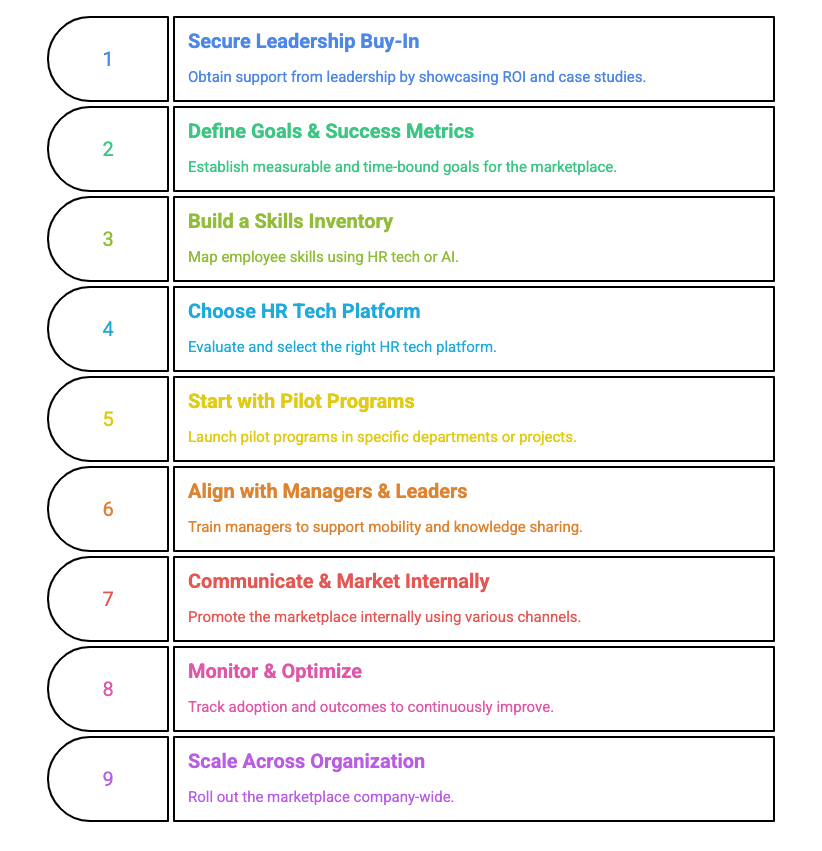Think about the last time one of your best employees left. Chances are, it wasn’t just about pay, it was because they didn’t see room to grow. This is where internal talent marketplaces come in.
Instead of losing people to outside opportunities, organizations can use HR tech to match employees with new projects, stretch assignments, or career shifts inside the company. Done right, it not only boosts retention but also helps leaders unlock hidden skills already sitting in their workforce.
But here’s the challenge: an internal talent marketplace isn’t just a plug-and-play tool. It requires thoughtful planning, the right HR tech, and a culture that encourages mobility.
That’s why we’ve broken it down into a 9-step framework, from building leadership buy-in to scaling across the organization, so you can see exactly what it takes to make this work.
What is An Internal Talent Marketplace?
An internal talent marketplace is not a passive bulletin board of job openings. It’s a system, usually powered by modern HR software and AI, that connects people inside the company to opportunities: full roles, short-term projects, stretch assignments, mentoring, and development pathways.
Think of it as the company’s own “LinkedIn,” but internal. Employees create profiles that go far beyond job titles, listing skills, career goals, interests, and experiences. Managers post roles, projects, stretch assignments, or mentoring opportunities.
The marketplace then uses AI and HR tech to match supply with demand: who has the skills, who wants to learn them, and where the business needs people most.
Why HR Technology Matters Here
You can’t run a credible internal marketplace with spreadsheets and good intentions alone. HR tech brings two things: scale and signal.
Systems like Workday’s Talent Marketplace or Salesforce’s Career Connect use skills data, behavioral signals, and machine learning to surface high-probability internal fits, even when the employee or the hiring manager hasn’t explicitly asked.
That matching reduces friction, shortens redeployment time, and makes internal moves visible instead of hidden. Organizations that invest in these tools get more out of their existing workforce rather than constantly chasing external hires.
Here is a step-by-step guide on how to leverage internal talent marketplaces with HR tech:
Building an Internal Talent Marketplace

Step 1: Define the Business Purpose
Don’t start with the tech, start with the “why.” Is your goal to cut recruiting costs? Retain top performers? Staff projects faster? Improve career development? Write it down and make it measurable.
If leadership sees it as “just another HR tool,” adoption will lag. Position it as a business accelerator: the fastest way to get the right people onto the right work.
Step 2: Map Skills And Gaps
With objectives set, inventory what your people can do today and what the business will need. That starts with a skills audit, such as pulling together performance data, self-reported capabilities, completion of learning paths, and future project forecasts.
Good platforms surface both current competencies and emerging needs, making it easier to highlight who could be ready for what with minimal uplift
The point isn’t perfect taxonomy on day one. Its visibility: showing where clusters of capability live, where shortages will pinch upcoming work, and what development nudges would move internal candidates closer to fit.
Step 3: Engage Stakeholders Early
An overlooked step: managers, employees, and HR teams must all feel ownership. Involve them before rollout. Ask managers what mobility fears they have. Ask employees what would make them actually use it. This co-design approach prevents the “HR built it, but nobody came” problem.
Step 4: Pick The Right Platform
Not every HR system will do this well. Look for a platform that:
- Understands skills at a granular level and can compare them against opportunities without manual tagging.
- Integrates with your existing HR data sources (HRIS, LMS, performance, career profiles) so it doesn’t live in a silo.
- Can suggest options to employees (roles, gigs, learning) based on their history and expressed interests, not just wait for them to browse.
Platforms vary in focus, some lean into career pathing, others into project staffing, and some emphasize equity or internal gig allocation. The best match depends on whether you’re prioritizing speed of fill, talent development, retention, or a combination.
Step 5: Build Rich Employee Profiles
The marketplace lives or dies by profile quality. Encourage employees to capture:
- Skills (both formal and informal)
- Career aspirations
- Past project experience
- Interests and learning goals
The best platforms reduce the burden by auto-updating profiles with data from performance reviews, learning completions, and project work.
Step 6: Pilot, Train, And Roll Out
Don’t launch everywhere at once. Pick a willing business unit or function, get their feedback, fix friction points, then expand. Early pilots build internal proof, showing real redeployments, shorter staffing cycle time, or positive employee stories.
Train managers and talent owners, too. They often fear losing people, so show them how internal moves can be framed as development, succession, or cross-team partnership, and help them see that surface visibility of their team’s skills can raise their credibility.
Support the rollout with internal comms: simple how-tos, early success vignettes, FAQs, and champions who’ve navigated internal moves.
Step 7: Shift Culture And Get Managers On Board
Internal mobility falters when managers treat talent as hoarded. The companies that get this right normalize internal moves as shared investment. That requires psychological safety; managers need to know that helping someone grow internally isn’t a loss but a signal of good leadership.
Give visibility to moves, celebrate transitions, and surface internal career pivots publicly. That makes the possibility real for others and reduces the feeling that internal mobility is opaque or unfair.
Step 8: Communicate and Celebrate
Don’t just launch a platform, tell stories. Share examples of employees who landed dream projects internally. Celebrate managers who supported internal moves. Make mobility visible and positive. This builds trust and interest more than any technical feature.
Step 9: Measure, Learn, Iterate
Use the metrics tied to your original goals. Typical signals: internal fill rate, average redeployment time, profile completeness, application conversion from recommendation, and qualitative feedback.
Watch for unintended friction. Are people applying but not getting matched? Are managers blocking moves? Adjust nudges, update taxonomy, refine manager incentives, and surface success stories to keep momentum.
Real Company Examples
These real-world stories show how organizations turned internal talent marketplaces into engines of engagement and agility. Schneider Electric, Unilever, and Salesforce each transformed how they redeploy, reskill, and surface hidden talent to fill roles from within, often far faster and cheaper than external hiring.
Schneider Electric – “Open Talent Market” by Gloat
Within one month of launch, Schneider Electric saw a 60% adoption rate, enabling over 2,300 employees to explore new roles. The platform unlocked nearly 127,000 hours of hidden capacity in only a few weeks.
By around 2025, that adoption grew to 89%, with over 13,400 gig matches and 27,500 mentor matches completed.
The initiative has also driven significant value, unlocking more than 360,000 hours and achieving $15 million in productivity gains and reduced recruiting costs.
Unilever – FLEX Experiences
Piloted with over 20,000 employees across 90+ countries, the platform unlocked 60,000 hours in a two-month period.
In other reporting, the initiative unlocked more than 112,000 hours of employee capacity, with several hundred active users and many finding new internal career opportunities.
During the COVID-19 period, the platform supported staffing over 700 critical projects and unlocked more than 26,000 hours, with a notable portion of assignments being cross-functional and global.
Additionally, nearly two-thirds of FLEX experiences were taken on by female employees, showcasing equitable access.
Salesforce – Career Connect / Career Agent
In a pilot involving 1,200 employees across several functions, 74% were actively engaged with the platform. Nearly 40% enrolled in recommended training, 28% applied for internal roles, and over 91% of filled roles were surfaced through Career Connect. In Q1 2025, 50% of roles were filled internally.
A firsthand user story: Brooke Grant received a Slack notification from Career Agent about a sales enablement position, highlighting her transferable skills. Within a month, she transitioned into the new role, an ideal example of the platform’s career-shaping potential.
Vendor Starting Points
A few platforms to examine, depending on your mix of needs:
- Workday Talent Marketplace: Leverages skills intelligence and integrates with broader HR data to surface internal fitting opportunities and recommends skill updates.
- Salesforce Career Connect / Agent: Brings career coaching and opportunity surfacing into employees’ daily flow, emphasizing internal discovery and reskilling.
- Gloat: Focused on internal agility; supports projects, mentoring, and career moves, with documented deployments at enterprises like Schneider Electric and Unilever.
- Avature Internal Mobility: Emphasizes unified profiles, rich skills taxonomy, and integration across talent processes to form a connected internal marketplace experience.
- Eightfold.ai: Uses deep talent intelligence with DEI-aware algorithms to surface internal mobility recommendations while tracking career paths and mitigating bias.
Pick the one that aligns with your data maturity, integration needs, and whether you want to start with a focused pilot or embed mobility across the enterprise quickly.
Important FAQs
What is an internal talent marketplace?
An internal talent marketplace is a digital platform that helps employees find new opportunities inside their company, such as projects, mentorships, or full-time roles, based on their skills and interests. It connects talent supply with business demand, powered by HR tech and often enhanced by AI.
How is an internal talent marketplace different from an external one?
An external talent marketplace focuses on recruiting outside candidates (like LinkedIn or Indeed). An internal marketplace is employee-only, designed to help current staff grow, develop, and shift into new opportunities without leaving the company.
What challenges do companies face when building an internal talent marketplace?
Common challenges include lack of leadership support, cultural resistance to internal mobility, outdated HR systems, data silos, and fears of losing top talent to other departments. Overcoming these requires clear communication, strong governance, and the right technology.
What role does HR tech play in enabling internal marketplaces?
HR tech platforms (like Gloat, Workday, Eightfold, or Fuel50) provide AI-driven matching, skills taxonomies, and integration with existing HRIS or LMS systems. They make it possible to scale internal mobility by automating opportunity matching and tracking outcomes.
How can success of an internal talent marketplace be measured?
Key metrics include adoption rates, internal mobility percentage, retention improvements, employee satisfaction scores, and time-to-fill for internal roles or projects.
Conclusion
Most companies sit on capable talent that never sees the spotlight, and modern HR tech gives a practical way to surface it when needed. Real progress comes when internal mobility becomes second nature: employees find new roles without leaving, and critical gaps are filled internally rather than waiting for external hires.
The order matters, from defining purpose, mapping skills, choosing a platform that connects to your data, building useful profiles and taxonomy, piloting with feedback, shifting culture, to iterating based on metrics, and that’s what turns intentions into everyday reality.
When that dynamic is in place, your internal marketplace becomes more than software; it’s a system that keeps talent active, morale high, and costs manageable. It’s worth getting a version running fast and learning as you grow.









